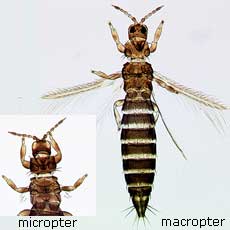Female
macropterous, or micropterous with wing lobe shorter than width of thorax;
body colour brown with yellow markings on head and pronotum; legs mainly
yellow, femora particularly with brown markings; antennal segment II
brown, I & III-IV paler; forewing weakly shaded with base even paler.
Antennae 8-segmented, III & IV with forked sense cone, VIII as long
as VII. Head wider than long; 3 pairs of ocellar setae present, pair
III slightly longer than side of ocellar triangle, arising just outside
anterior margins of triangle; postocular setae pair I absent, pair IV
slender and no longer than one hind ocellus. Pronotum with 5 pairs of
major setae; anteromarginal setae distinctly smaller than anteroangulars,
one pair of minor setae present medially between posteromarginal submedian
setae. Metanotum with 2 pairs of setae at anterior margin, campaniform
sensilla present. Forewing with 2 complete rows of veinal setae. Tergites
V-VIII with pair of lateral ctenidia (weakly developed pair also on IV),
on VIII anterolateral of spiracle; tergite VIII with no posteromarginal
comb. Sternites III-VII without discal setae.
Male macropterous, or micropterous, smaller and paler than female; tergite
IX with median pair of setae slender; sternites III-VII with glandular
area transverse and narrow to broadly oval.
Second instar larva yellow with legs and antennae grey, also tergite X
and most of IX; tergites with transverse rows of small linear plaques,
dorsal setae all blunt, tergite IX campaniform sensilla wide apart almost
anterior to B2, posterior margin with row of small teeth. |
